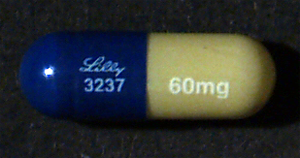| name | Duloxetine |
| classification | Selective Serotonin and Norepinephrine Reuptake Inhibitors (SNRIs) |
| pharmacokinetics | Duloxetine is primarily metabolized in the liver by CYP2D6. The half-life is approximately 12 hours, and steady state concentrations are achieved within 1-4 weeks. Significant food effects are not observed, though absorption is typically slightly slower. Renal excretion is a minor route. |
| suggested dosage | | male patient 25 70kg | | initial dose | 40 mg once daily | | titration | May be increased to 60-80 mg daily, as tolerated and monitored by physician; can be divided into twice daily doses, if required for better tolerability | | max dose | 120 mg daily | | important note | Dosage should be adjusted based on individual patient response and tolerability, with close monitoring by a healthcare professional. |
| | general note | Consult with a healthcare professional to determine the appropriate dosage for your specific needs. |
|
| indications | Duloxetine is primarily used for major depressive disorder (MDD), generalized anxiety disorder (GAD), diabetic peripheral neuropathic pain, fibromyalgia, and chronic musculoskeletal pain. It may also be used for other conditions like post-traumatic stress disorder (PTSD) and social anxiety disorder |
| safety in pregnancy | Duloxetine use during pregnancy should be carefully considered, as the effects of the medication on the developing fetus are not fully understood. Use is generally discouraged in the first trimester. Consult with your physician for detailed information and potential risks. |
| safety in breastfeeding | Duloxetine passes into breast milk. The potential risks to the nursing infant are not fully understood, so breastfeeding should be discontinued or the medication should be considered only under strict medical supervision. |
| side effects | | 1 | Nausea | | 2 | Headache | | 3 | Constipation | | 4 | Drowsiness | | 5 | Dry mouth | | 6 | Sweating | | 7 | Sexual dysfunction | | 8 | Weight changes | | 9 | Insomnia | | 10 | Increased blood pressure and heart rate (though generally mild) | | 11 | Elevated liver enzymes (monitor as needed). |
|
| alternatives | |
| contraindications | | 1 | Known hypersensitivity to duloxetine or other components of the medication | | 2 | Severe hepatic impairment | | 3 | Severe renal impairment | | 4 | Concomitant use with MAOIs (monoamine oxidase inhibitors) within 14 days. |
|
| interactions | Duloxetine interacts with several medications, including MAOIs, CYP2D6 inhibitors (e.g., certain antidepressants, antihistamines), and certain drugs affecting liver function. Always inform your physician about all medications you are currently taking. |
| warnings and precautions | | 1 | Increased risk of suicidal thoughts or behavior, especially in young adults | | 2 | Monitor for signs of serotonin syndrome if taken with other serotonin-enhancing medications (e.g., other antidepressants, triptans) | | 3 | Dosage adjustments may be needed in patients with renal impairment | | 4 | Closely monitor patients with liver disease | | 5 | Use caution in patients with pre-existing hypertension or other cardiovascular conditions. | | 6 | Sudden discontinuation can lead to withdrawal symptoms. Dosage should be tapered. |
|
| additional informations | This information is for educational purposes only and is not a substitute for professional medical advice. Consult with a healthcare provider or pharmacist for personalized guidance on duloxetine use. |

